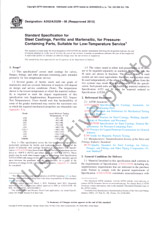We need your consent to use the individual data so that you can see information about your interests, among other things. Click "OK" to give your consent.
ASTM B1023-22
Standard Test Method for Abrasion Resistance of Hard Anodic Coatings by a Taber-Type Abraser
Translate name
STANDARD published on 1.8.2022
The information about the standard:
Designation standards: ASTM B1023-22
Publication date standards: 1.8.2022
SKU: NS-1083888
The number of pages: 8
Approximate weight : 24 g (0.05 lbs)
Country: American technical standard
Category: Technical standards ASTM
Annotation of standard text ASTM B1023-22 :
Keywords:
abrader, abraser, abrasion, abrasion resistance, anodized alumimum, Taber-type, wear,
Additional information
| Significance and Use |
|
5.1?Hard anodic oxidation coatings are often used to obtain improved resistance to abrasion, and have been used in such applications as valves, sliding parts, hinge mechanisms, cams, gears, swivel joints, pistons, insulation plates, blast shields, etc. 5.2?This abrasion resistance test method may be useful for acceptance testing of a hard anodic coating, and it can be used to evaluate the effects of processing variables such as substrate preparation before coating, surface texture, coating technique variables, and post coating treatments. 5.3?Results may be used for process control, comparative ranking, or to correlate with end-use performance. The resistance of material surfaces to abrasion, as measured on a testing machine in the laboratory, is generally only one of several factors contributing to wear performance as experienced in the actual use of the material. Other factors may need to be considered in any calculation of predicted life from specific abrasion data. 5.4?The properties and characteristics of hard anodic oxidation coatings are significantly affected by both the alloy and the method of production. Note 2:?Hard anodizing will usually result in a dimensional
increase on each surface equal to about 50 % of the coating
thickness. Normal thickness for wear applications tends to be 40 ?m
to 60 ?m; however the thickness of anodized coatings often ranges
between 8 ?m to 150 ?m.
5.5?The resistance of hard anodic coatings to abrasion may be affected by factors including test conditions, type of abradant, pressure between the specimen and abradant, composition of the alloy, thickness of the coating, and the conditions of anodizing or sealing, or both. Note 3:?The resistance to abrasion is generally measured on
unsealed anodic oxidation coatings. While corrosion resistance is
often increased by sealing the coating, it has been observed that
sealing or dyeing can reduce the resistance to abrasion by over 50
%.
5.6?The outer surface of the anodic coating may be softer or less dense which may cause a greater mass loss in the first 1000 abrasion cycles than the remaining cycles. Two similar procedures are described in this test method. Method B does not report the first 1000 abrasion cycles, so any surface variation that may exist is reduced and a more representative value for the bulk coating is obtained. 5.7?Abrasion tests utilizing a Taber-type abraser may be subject to variation due to changes in the abradant during the course of specific tests. Depending on abradant type and test specimen, the abrasive wheel surface may become clogged due to the adhesion of wear debris generated during the test to the surface of the wheel. To provide a consistent rate of wear, the abrasive wheels must be resurfaced at defined intervals. |
| 1. Scope |
|
1.1?This test method quantifies the abrasion resistance of electrolytically formed hard anodic oxidation coatings on a plane, rigid surface of aluminum or aluminum alloy. 1.2?This test uses a Taber-type abraser,2 which generates a combination of rolling and rubbing to cause wear to the coating surface. Wear is quantified as cumulative mass loss or loss in mass per thousand cycles of abrasion. 1.3?UnitsThe values stated in SI units are to be regarded as standard. No other units of measurement are included in this standard. Note 1:?The procedure described in Method A is similar to
MIL-PRF-8625 (paragraph 4.5.5) and SAE AMS 2469 (paragraph 3.3.4).
The procedure described in Method B includes a break-in period of
1000 cycles and is similar to ISO 10074 Annex B. When no procedure
is specified, Method A shall be the default procedure. Although the
procedures described in this method may be similar, they are not
equivalent to Specification B893 or Test Method D4060.
1.4?This standard does not purport to address all of the safety concerns, if any, associated with its use. It is the responsibility of the user of this standard to establish appropriate safety, health, and environmental practices and determine the applicability of regulatory limitations prior to use. 1.5?This international standard was developed in accordance with internationally recognized principles on standardization established in the Decision on Principles for the Development of International Standards, Guides and Recommendations issued by the World Trade Organization Technical Barriers to Trade (TBT) Committee. |
We recommend:
Technical standards updating
Do you want to make sure you use only the valid technical standards?
We can offer you a solution which will provide you a monthly overview concerning the updating of standards which you use.
Would you like to know more? Look at this page.




 Cookies
Cookies
